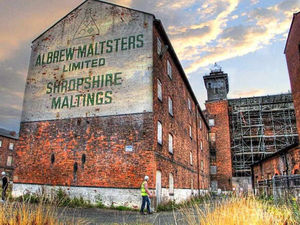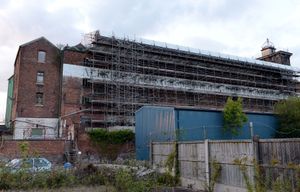Shrewsbury Flaxmill development: Making an iconic old building busy again
It was built in 1797 and was Shrewsbury's largest employer. Now, 220 years later, The Flaxmill Maltings is set for multi-million pound renovation that will again bring the activity of work to the building.

Ultimately the site is intended to become a centre for new businesses, homes, as well as a celebration of the building's place in history.
For many the project is not just about making use of the site and its potential, but safeguarding a building of international importance, which has faced falling into wrack and ruin.
Its significance is not immediately obvious to the casual observer with the very framework of the building representing one of the biggest steps forward in human construction.

The iron frame around which the building was created sets it out as the pre-cursor to modern skyscrapers which have come to dominate the landscape in the world's biggest cities.
It has been described as the forerunner to modern skyscrapers, and cost £17,000 to build.
In a sign of how times have move on, earlier this year the Heritage Lottery Fund confirmed it would provide extra money for the project to restore the building to its former glory, taking the total funding to £20 million.
Ros Kerslake, chief executive of the Heritage Lottery Fund said the building's historical importance had played a huge part in the decision to back the project when they announced the funding earlier this year.
She said: "Shrewsbury Flaxmill Maltings is an extraordinary part of our industrial heritage which changed the world of construction and design with its revolutionary iron frame. It is the forerunner to modern skyscrapers which define our cityscapes today."
Speaking after the funding was confirmed Chris Smith, planning director with Historic England paid tribute to the efforts of those who have worked to make the project a reality.
He said: “It has taken a long time and enduring support from friends, Shropshire, and all funders, foremost amongst them HLF to get to this great moment. Now Historic England and allies can achieve the repair and viable re-use of one of the world’s most important buildings. The Flaxmill will stand at the heart of a developing site which will bring vitality to the northern part of Shrewsbury. The repaired building and redeveloped site will become another of the many great assets of Shrewsbury and Shropshire.
After the flaxmill was built it became the biggest employer in Shrewsbury. However, the flax business declined in the 1870s and the mill closed in 1886. The site was converted into a maltings in 1897 to 1898, when the Kiln was added.
After being used as a temporary barracks during the Second World War, the site resumed as a maltings until its closure in 1987.
The project will see the full restoration of the Main Mill and Kiln, listed as items of international architectural importance and currently on English Heritage's "at risk register".

A cafe will be included in the development, along with an "interpretation and learning space" and four floors of commercial space.
The work, which will be carried out by Croft Building and Conservation will include structural repairs to the Main Mill and reintroducing windows that were closed during the Maltings phase.
Historic England said the move would "flood the building with natural light". Once complete the company will move onto work on the kiln.
Councillor Nic Laurens, portfolio holder for economic growth for Shropshire Council said the site would be of huge importance to Shrewsbury.
He said: “It’s great news that a contractor has been appointed and is about to start work to restore the impressive and internationally important Grade I Flax Mill and Grade II listed Kiln.
“Bringing these two buildings back to life has been the greatest challenge for the partners, but the impact they will have on completion should not be underestimated. The site will be transformed and this stage of works will be the important catalyst for further development across the whole of the wider masterplan site.
"We are really grateful to the Heritage Lottery Fund for the significant funds required to progress the works."
The efforts of the partnership behind the project, Historic England, the Friends of Ditherington Flaxmill, and Shropshire Council, have already seen the creation of a visitor centre in a former office and stables, which opened in November 2015.
Once the next stage of the project is complete then Historic England has said it will look at the 'master plan' for the development, which could include the creation of homes on the brownfield land contained in the site.
For those that want to find out more about the site and its history then the visitor centre teaches how flax was processed, from the field to the end product which include a myriad of items from ship sails to playing cards.
It also shows the impact of the building's revolutionary iron frame on the world of architecture as well as providing details of the mill's machinery and technology, and working conditions including child labour.




